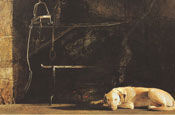
Ides of March
Sycamore Tree and Hunter
Because Andrew Wyeth felt a strong need to establish his own style and approach to art, he did not follow the footsteps of his father N. C. Wyeth and pursue a career in commercial illustration. Nevertheless, some of his works did make the covers of various magazines, and it was the appearance of “Sycamore Tree and Hunter” on the cover of the popular Saturday Evening Post on October 16, 1943, that brought him to the attention of the entire nation.
Often referred to as simply “The Hunter”, the painting’s predominant feature is a striking and finely detailed sycamore tree. It becomes immediately obvious that the perspective is from up high, at the summit of the tree. Looking all the way down the tree’s trunk, through the winding branches to the forest floor below, one finds the small figure of the hunter underneath the tree. It was this exclusive and dramatic bird’s eye-view that so impressed the viewers.